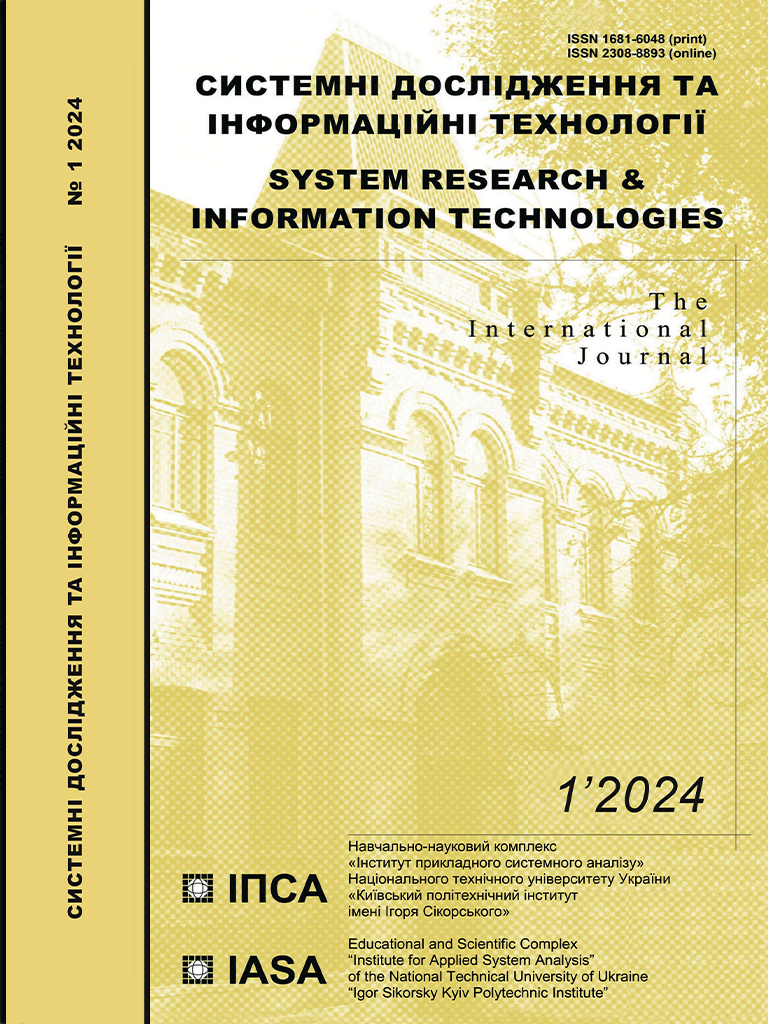Cardiomyopathy prediction in patients with permanent ventricular pacing using machine learning methods
DOI:
https://doi.org/10.20535/SRIT.2308-8893.2024.1.03Keywords:
permanent ventricular pacing, risk factors, artificial intelligence, forecasting, machine learningAbstract
Pacing-induced cardiomyopathy is a notable issue in patients needing permanent ventricular pacing. Identifying risk groups early and swiftly preventing the ailment can reduce patient harm. However, current prognostic methods require clarity. We employed machine learning to develop predictive models using medical data. Three algorithms — decision tree, group method of data handling, and logistic regression — formed models that forecast pacing-induced cardiomyopathy. These models displayed high accuracy in predicting development, signifying soundness. Factors like age, paced QRS width, pacing mode, and ventricular index during implantation significantly influenced predictions. Machine learning can enhance pacing-induced cardiomyopathy prediction in ventricular pacing patients, aiding medical practice and preventive strategies.
References
J.C. Nielsen, L. Kristensen, H.R. Andersen, P.T. Mortensen, O.L. Pedersen, and A.K. Pedersen, “A randomized comparison of atrial and dual-chamber pacing in 177 consecutive patients with sick sinus syndrome,” Journal of the American College of Cardiology, 42(4), pp. 614–23, 2003. doi: 10.1016/S0735-1097(03)00757-5.
M.O. Sweeney et al., “Adverse Effect of Ventricular Pacing on Heart Failure and Atrial Fibrillation Among Patients With Normal Baseline QRS Duration in a Clinical Trial of Pacemaker Therapy for Sinus Node Dysfunction,” Circulation, 107(23), pp. 2932–2937, 2003. doi: 10.1161/01.CIR.0000072769.17295.B1.
The DAVID Trial Investigators*, “Dual-Chamber Pacing or Ventricular Backup Pacing in Patients With an Implantable Defibrillator,” JAMA, 288(24), pp. 3115–3123, 2002. doi: 10.1001/jama.288.24.3115.
S. Khurshid et al., “Incidence and predictors of right ventricular pacing-induced cardiomyopathy,” Hear Rhythm, 11(9), pp. 1619–1625, 2014. doi: 10.1016/j.hrthm.2014.05.040.
E.L. Kiehl et al., “Incidence and predictors of right ventricular pacing-induced cardiomyopathy in patients with complete atrioventricular block and preserved left ventricular systolic function,” Hear Rhythm, 13(12), pp. 2272–2278, 2016. doi: 10.1016/j.hrthm.2016.09.027.
A. Abdin et al., “Incidence and predictors of pacemaker induced cardiomyopathy: A single-center experience,” Journal of Electrocardiology, 57, pp. 31–34, 2019. doi: 10.1016/j.jelectrocard.2019.08.016.
Mohamed Abdelmohsen Sayed, Haitham Abd El Fatah Badran, Said Khaled, and Emad Effat Fakhry, “Predictors of right ventricular pacing-induced left ventricular dysfunction in pacemaker recipients with preserved ejection fraction,” Herzschrittmachertherapie + Elektrophysiologie, 33(3), pp. 312–318, 2022. doi: 10.1007/s00399-022-00880-w.
H.T. Perla, S. Chandra Srinath Patloori, A. Manickavasagam, D. Chase, and J. Roshan, “Do the predictors of right ventricular pacing-induced cardiomyopathy add up?” Indian Heart Journal, 73(5), pp. 582–587, 2021. doi: 10.1016/j.ihj.2021.07.011.
J.H. Kim, K.-W. Kang, J.Y. Chin, T.-S. Kim, J.-H. Park, and Y.J. Choi, “Major determinant of the occurrence of pacing-induced cardiomyopathy in complete atrioventricular block: a multicentre, retrospective analysis over a 15-year period in South Korea,” BMJ Open, 8(2), pp. e019048, 2018. doi: 10.1136/bmjopen-2017-019048.
S.W. Cho et al., “Clinical features, predictors, and long-term prognosis of pacing-induced cardiomyopathy,” European Journal of Heart Failure, 21(5), pp. 643–651, 2019. doi: 10.1002/ejhf.1427.
M. Abdelrahman et al., “Clinical Outcomes of His Bundle Pacing Compared to Right Ventricular Pacing,” Journal of the American College of Cardiology, 71(20), pp. 2319–2330, 2018. doi: 10.1016/j.jacc.2018.02.048.
P.S. Sharma et al., “Clinical outcomes of left bundle branch area pacing compared to right ventricular pacing: Results from the Geisinger-Rush Conduction System Pacing Registry,” Hear Rhythm, 19(1), pp. 3–11, 2022. doi: 10.1016/j.hrthm.2021.08.033.
P. Vijayaraman et al., “Outcomes of His-bundle pacing upgrade after long-term right ventricular pacing and/or pacing-induced cardiomyopathy: Insights into disease progression,” Hear Rhythm, 16(10), pp. 1554–1561, 2019. doi: 10.1016/j.hrthm.2019.03.026.
L.M. Rademakers, S. Bouwmeester, T.P. Mast, L. Dekker, P. Houthuizen, and F.A. Bracke, “Feasibility, safety and outcomes of upgrading to left bundle branch pacing in patients with right ventricular pacing induced cardiomyopathy,” Pacing and Clinical Electrophysiology, 45(6), pp. 726–732, 2022. doi: 10.1111/pace.14515.
K. Basu, R. Sinha, A. Ong, and T. Basu, “Artificial intelligence: How is it changing medical sciences and its future?” Indian Journal of Dermatology, 65(5), pp. 365–370, 2020. doi: 10.4103/ijd.IJD_421_20.
Ch Anwar Ul Hassan et al., “Effectively Predicting the Presence of Coronary Heart Disease Using Machine Learning Classifiers,” Sensors, 22(19), 7227, 2022. doi: 10.3390/s22197227.
O. Petrunina, D. Shevaga, V. Babenko, V. Pavlov, S. Rysin, and I. Nastenko, “Comparative Analysis of Classification Algorithms in the Analysis of Medical Images From Speckle Tracking Echocardiography Video Data,” Innovative Biosystems and Bioengineering, 5(3), pp. 153–166, 2021. doi: 10.20535/ibb.2021.5.3.234990.
J. Wang, “Heart Failure Prediction with Machine Learning: A Comparative Study,” Journal of Physics: Conference Series, 2031(1), 12068, 2021. doi: 10.1088/1742-6596/2031/1/012068.
M. Varshneya, X. Mei, and E.A. Sobie, “Prediction of arrhythmia susceptibility through mathematical modeling and machine learning,” Proceedings of the National Academy of Sciences, 118(37), 12068, 2021. doi: 10.1073/pnas.2104019118.
E.R. Pujadas et al., “Atrial fibrillation prediction by combining ECG markers and CMR radiomics,” Scientific Reports, 12(1), 18876, 2022. doi: 10.1038/s41598-022-21663-w.
P.Z. Fruelund et al., “Risk of Pacing-Induced Cardiomyopathy in Patients with High-Degree Atrioventricular Block—Impact of Right Ventricular Lead Position Confirmed by Computed Tomography,” Journal of Clinical Medicine, 11(23), 7228, 2022. doi: 10.3390/jcm11237228.
J. Mizner, P. Jurak, H. Linkova, R. Smisek, and K. Curila, “Ventricular Dyssynchrony and Pacing-induced Cardiomyopathy in Patients with Pacemakers, the Utility of Ultra-high-frequency ECG and Other Dyssynchrony Assessment Tools,” Arrhythmia & Electrophysiology Review, 11, e.17, 2022. doi: 10.15420/aer.2022.01.
I.H. Sarker, “Machine Learning: Algorithms, Real-World Applications and Research Directions,” SN Computer Science, 2(3), 160, 2021. doi: 10.1007/s42979-021-00592-x.
A. Rajkomar, J. Dean, and I. Kohane, “Machine Learning in Medicine,” The New England Journal of Medicine, 380(14), pp. 1347–1358, 2019. doi: 10.1056/nejmra1814259.
V. Babenko et al., “Classification of Pathologies on Medical Images Using the Algorithm of Random Forest of Optimal-Complexity Trees,” Cybernetics and Systems Analysis, 59(2), pp. 346–358, 2023. doi: 10.1007/s10559-023-00569-z.
B. Charbuty, A. Abdulazeez, “Classification Based on Decision Tree Algorithm for Machine Learning,” Journal of Applied Science and Technology Trends, 2(1), pp. 20–28, 2021. doi: 10.38094/jastt20165.
V. Vaishnav, J. Vajpai, “Assessment of impact of relaxation in lockdown and forecast of preparation for combating COVID-19 pandemic in India using Group Method of Data Handling,” Chaos, Solitons & Fractals, 140, 110191, 2020. doi: 10.1016/j.chaos.2020.110191.
C. El Morr, M. Jammal, H. Ali-Hassan, and W. El-Hallak, “Logistic Regression,” in book “Machine Learning for Practical Decision Making,” pp. 231–249, 2022. doi: 10.1007/978-3-031-16990-8_7.
Ž.Ð. Vujovic, “Classification Model Evaluation Metrics,” International Journal of Advanced Science and Computer Applications, 12(6), 2021. doi: 10.14569/IJACSA.2021.0120670.

